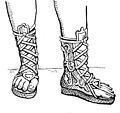Sock and buskin
Appearance

The sock and buskin are two ancient symbols of comedy and tragedy. In ancient Greek theatre, actors in tragic roles wore a boot called a buskin (Latin cothurnus). The actors with comedic roles wore only a thin-soled shoe called a sock (Latin soccus).
-
Sock
-
Buskin
Melpomene, the muse of tragedy, is often depicted holding the tragic mask and wearing buskins. Thalia, the muse of comedy, is similarly associated with the mask of comedy and comic's socks. Some people refer to the masks themselves as "Sock and Buskin."[1]
References
- ^ Charles Mackay (1887). A Glossary of Obscure Words and Phrases in the Writings of Shakspeare and His Contemporaries Traced Etymologically to the Ancient Language of the British People as Spoken Before the Irruption of the Danes and Saxons. S. Low, Marston, Searle, and Rivington. p. 48.


